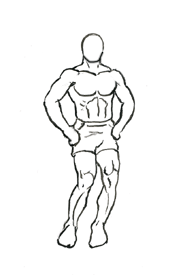Last Updated on September 26, 2014
Knee circles are often overlooked in fitness routines, but they offer significant benefits for mobility, flexibility, and joint health. This low-impact movement, which involves rotating the knees in a circular pattern, is ideal for warming up, enhancing joint flexibility, and improving balance. Whether you’re an athlete, a fitness enthusiast, or someone looking to maintain joint health, knee circles are a fantastic addition to any exercise regimen.
In this comprehensive guide, we’ll explore the importance of knee circles, how to perform them correctly, their benefits, variations, and the common mistakes to avoid. By the end, you’ll have everything you need to know to make the most of this simple yet effective exercise.
What Are Knee Circles?
Knee circles are a dynamic stretch and mobility exercise that involves moving the knees in a circular motion while standing. The movement engages not only the knees but also the ankles, hips, and surrounding muscles, providing a full lower-body stretch. It’s a gentle exercise that promotes blood flow and helps loosen up the joints, making it ideal for warming up before workouts or for those who need a low-impact movement to maintain joint mobility.
Muscles Worked During Knee Circles
Knee circles primarily target the following muscles and areas:
- Knee Joints: The circular motion activates the knee joints, promoting flexibility and mobility.
- Ankles: The movement requires ankle stability, which helps strengthen and improve ankle flexibility.
- Calves and Shins: The exercise engages the lower leg muscles, aiding in balance and stability.
- Quadriceps and Hamstrings: These muscles work to stabilize the legs and support the circular movement of the knees.
- Hips: The hips also play a role in stabilizing the movement, providing a gentle stretch to the hip flexors.
How to Perform Knee Circles: Step-by-Step Guide
Performing it correctly ensures that you maximize their benefits while reducing the risk of injury. Follow these steps to execute the exercise with proper form:
- Set Up:
- Stand with your feet positioned slightly closer than shoulder-width apart.
- Your feet should be flat on the floor, and your toes pointing forward.
- Position Your Arms:
- Place your hands on your hips or cross your arms over your chest for balance. Either position helps you focus on engaging your lower body and maintaining stability.
- Bend Your Knees Slightly:
- Bend your knees gently to bring them into a comfortable position. Your knees should not extend past your toes, and your back should remain straight. This prepares the joints for the circular motion.
- Begin the Circular Motion:
- Slowly move your knees in a circular motion. Start by pushing your knees out to the side, then forward, bringing them together as you circle back inward.
- Perform the motion slowly, ensuring that your feet remain flat on the ground and the movement is primarily in the knees and ankles.
- Repeat the motion in one direction for 10-15 circles, then switch to the opposite direction.
- Pay Attention to Your Ankles:
- While performing knee circles, be mindful of your ankle movement. The ankles should remain stable, with the feet flat on the floor, to prevent strain.
Tips for Proper Form
To ensure you get the most out of knee circles while maintaining safety, consider the following tips:
- Keep Movements Slow and Controlled: Avoid rushing through the exercise. Slow, controlled movements help you maintain balance and engage the muscles effectively.
- Engage Your Core: Tightening your core muscles helps stabilize your torso, allowing your lower body to move more freely without compromising posture.
- Maintain a Neutral Spine: Keep your back straight and avoid leaning forward or backward. A neutral spine ensures proper alignment and reduces the risk of strain.
- Monitor Ankle Stability: It’s crucial to keep your feet flat on the floor throughout the exercise. If you have a history of ankle issues, be cautious with this movement, or consult a professional before incorporating it into your routine.
Benefits of Knee Circles
Knee circles might seem simple, but they offer a range of benefits for your joints, muscles, and overall mobility:
- Improves Knee Flexibility: By gently rotating the knees, this exercise helps increase knee flexibility, making it easier to perform other movements like squats, lunges, and various sports activities.
- Enhances Ankle Mobility: Knee circles engage the ankles, helping to improve flexibility and stability. This is particularly beneficial for activities that require quick changes in direction or balance, such as running or basketball.
- Warms Up the Lower Body: Knee circles are an excellent warm-up exercise. They promote blood flow to the muscles and joints, preparing the body for more intense physical activity.
- Aids in Injury Prevention: By increasing joint flexibility and mobility, knee circles help prevent injuries related to stiffness, particularly in the knees and ankles. Athletes and fitness enthusiasts can benefit from this exercise before engaging in high-impact activities.
- Improves Balance and Stability: The movement requires coordination and stability, which helps enhance your balance. Incorporating knee circles regularly can lead to improved body awareness and stability during other exercises and daily activities.
Variations of Knee Circles
Once you’ve mastered the basic knee circle, there are several variations to try, each offering unique benefits:
1. Wide-Stance Knee Circles
Widen your stance to increase the range of motion, which adds a challenge to the exercise and engages the hips more intensely.
- How to Perform: Stand with your feet wider than shoulder-width apart. Bend your knees slightly and perform the circular motion. The wider stance works the hips and inner thighs while still engaging the knees and ankles.
2. Single-Leg Knee Circles
This variation enhances balance and stability, targeting the stabilizing muscles in the ankle and foot.
- How to Perform: Stand on one leg with the other leg slightly lifted. Move the knee of the lifted leg in a circular motion while maintaining balance. Switch legs after 10-15 repetitions. This variation is more advanced and may require practice to maintain stability.
3. Seated Knee Circles
This variation is suitable for those with balance issues or anyone needing a gentler option, such as older adults or individuals recovering from injury.
- How to Perform: Sit on a sturdy chair with your feet flat on the floor. Lift one foot slightly off the ground and rotate the knee in a circular motion. Repeat on the other side. This seated variation still promotes knee mobility while offering a safe, supported position.
Common Mistakes to Avoid
To perform knee circles safely and effectively, it’s essential to avoid these common mistakes:
- Lifting the Heels Off the Ground: The exercise is most effective when your feet remain flat. Lifting the heels shifts the focus away from the knee and ankle joints and may cause instability. Focus on keeping your feet planted to maintain control.
- Rushing the Movement: Performing knee circles too quickly reduces their effectiveness and increases the risk of injury. Slow, controlled movements allow for greater muscle engagement and better mobility results.
- Leaning Forward or Backward: A neutral spine is crucial for knee circles. Leaning compromises balance and can strain your lower back. Keep your posture upright and your core engaged for stability.
- Neglecting Ankle Stability: If you have a history of ankle issues or instability, this exercise may not be suitable without professional guidance. Be mindful of your ankle position and avoid any discomfort or pain during the movement.
Programming Knee Circles into Your Routine
Knee circles are versatile and can be integrated into various parts of your fitness routine:
- Warm-Up Routine: Incorporate knee circles at the start of your workout for 1-2 minutes to warm up the lower body joints and muscles.
- Cool-Down Stretch: Use knee circles as part of your cool-down to release tension in the knees and ankles after intense activity.
- Rehabilitation Programs: For individuals recovering from lower body injuries (with professional guidance), knee circles can help restore mobility and joint flexibility. Start with short sessions and low repetitions, gradually increasing as you gain strength and mobility.
FAQs About Knee Circles
Q1: Are knee circles safe for everyone?
Knee circles are generally safe for most people. However, individuals with knee injuries, unstable ankles, or severe joint issues should consult a healthcare professional before performing this exercise.
Q2: How often should I do knee circles?
Knee circles can be done daily, especially as part of a warm-up or mobility routine. They are gentle enough for regular use and beneficial for maintaining joint health.
Q3: Can knee circles help with knee pain?
Knee circles can improve flexibility and mobility, which may help alleviate mild knee stiffness. However, if you experience knee pain during the exercise, stop immediately and consult a medical professional for proper assessment.
Knee circles are a simple yet powerful exercise that provides numerous benefits for joint mobility, flexibility, and balance. Whether you are warming up before a workout, cooling down after, or aiming to maintain joint health, this low-impact movement is easy to incorporate into any fitness routine. By performing knee circles with proper technique and control, you can improve knee and ankle flexibility, enhance balance, and prevent injuries, making it a valuable addition to your exercise repertoire.
Embrace the simplicity and effectiveness of knee circles, and enjoy the enhanced mobility and flexibility they bring to your daily life and workout routines.


Exercise images by Everkinetic.






